Volunteering for All: national framework - literature review
This report outlines a systematic review of the research literature on volunteering.
Motivations and barriers to volunteering
This section focuses on volunteer motivations and barriers to volunteering. These areas are the most commonly cited in the literature reviewed in regards to volunteering activity.

Motivations to volunteering
A great number of papers touched on the topic of the motivations of volunteers. There seems to be a general agreement in the contemporary literature that motivations to volunteering are complex and multi-faceted. Although conducted earlier than this literature review’s focus, a significant piece of research in this area includes E. G. Clary, Snyder, and Ridge (1992) who proposed six motivational functions:
(a) values (relating to altruistic and humanitarian concerns);
(b) understanding (e.g. new learning experience or practicing skills or knowledge);
(c) social (e.g. interacting with others);
(d) career (relating specifically to career development);
(e) protective (e.g. eliminating negative feelings to protect the ego); and
(f) enhancement (e.g. increasing positive strivings of the ego).
Building on this six-dimension framework, they developed an instrument, the Volunteer Functions Inventory (VFI) (E. Gil Clary et al., 1998), which has been widely used in subsequent research as a tool to assess volunteers’ motivations.
Erasmus and Morey (2016) explored the applicability of the VFI to faith-based volunteers, which led to an amended four-functions model, including: (a) values, (b) social, (c) career, and (d) enrichment. This new model eliminated protective function in the VFI. The newly added enrichment function is a combination of the elements from the understanding and enhancement functions.
There are also alternative ways of categorising volunteer motivations in the literature. For instance, In a survey of volunteers of the PyeongChang 2018 Winter Olympic Games, Y.-J. Ahn (2018) grouped motivations into four categories:
- leisure motivation, relating to relaxation and recreational needs;
- egoistic, relating to self-actualisation or self-esteem;
- purposive motivation, referring to making contributions to the event or community;
- external influence, such as family, friends or other significant others.
Drawing on data from Turkish college students, Boz and Palaz (2007) grouped their motivations into three categories: altruism, affiliation, and personal improvement.
In the literature reviewed, we identified two motivations based on the VFI framework that are most frequently identified: altruism; and instrumental motivations relating to career, employability and self-improvement.
Table 8 summarises the volunteering motivations themes, and the quality of the research evidence for those motivations. We have the strongest evidence for altruistic and values-based motivations in volunteering.
Table 8: A summary of volunteering motivations

Values, Altruism and helping others
A study focusing on British hospice volunteers found that altruistic motives were the most influential reasons for choosing to join the hospice; while personal gain motives were the least influential reasons (Claxton-Oldfield, Claxton-Oldfield, Paulovic, et al., 2013). Similarly, a survey of volunteer drivers showed that the top five motivations for their involvement were (in order): (a) to help others, (b) to do something meaningful, (c) to give back, (d) to stay active, and (e) because they were asked (Kerschner & Rousseau, 2008). Drawing on data from Turkish college students, Boz and Palaz (2007) grouped their motivations into three categories (in order): altruism, affiliation, and personal improvement.
A qualitative study of volunteer AIDS caregivers in South Africa found that the motivating factors for volunteers tended to be complex and varied (Akintola, 2011). The most frequently reported motivations were altruistic concerns for others, community, career and looking for activities while unemployed. Gates and colleagues (2016) looked at volunteers from the LGBTQ[3] community, reporting that connectedness, socialisation and genuine concern for meeting needs of LGBTQ communities were the strongest motivators for LGBTQ volunteers.
Based on a survey of emergency service volunteers in Australia, Francis and Jones (2012) compared the difference between young (under 35) and older (35 or above) volunteers, finding that the most important motivations for both age groups were values and understanding. Younger volunteers placed relatively more importance on career and protective motivations compared with those who were older.
Motivations to volunteering therefore varies by age groups, with younger people more likely linked to career or employment-related motivations and older people linked to more altruistic motivations. Interestingly, studies that looked at more under-represented groups highlighted that values-driven motivations became more important.
Career and Employability
Focusing on students in English Higher Education, Holdsworth (2010) identified three main themes of volunteer motivation, including employability, personal value and opportunity. Employability is mentioned more frequently over other motivations, and the students who are motivated by employability are more likely to seek out structured activities. Drawing data from qualitative interviews, Holdsworth (2010) argued that student volunteering was not necessarily goal-orientated or according with a strategic plan, rather it could relate as much to student's self-identity, as well as giving them the opportunity to do something different and challenging, while also having fun and escaping from the rigours of study or work. Anderson and colleagues (2018) conducted a qualitative study on volunteers in a university community garden, finding that the most common motivations were to increase knowledge, altruistic and career related motivations.
A study of recent African immigrants in Canada showed volunteering is primarily driven by career-related motives, such as to gain skills and to help job search (Chareka et al., 2010). Other motivations identified in the same study included cultural norms of ‘helping the less fortunate people’ and of being a 'global citizen'.
Characteristics relating to motivation
An important point emerged from the literature review: volunteers’ motivations were related to personal characteristics of individual volunteers. Based on the VFI, Clary and colleagues (1996) found that younger people, especially those in early adulthood, tend to place more importance on career, understanding and protective motivations compared with those who were in order age groups. Similarly, a study through in-depth interview with volunteers at the London 2012 Olympic Games showed that in general older volunteers were more likely to express altruistic values, while younger volunteers tend to report motivations related to employability (Geoffrey Nichols & Ralston, 2016). A study of health care executives found that Chief Executive Officers were more likely to be motivated by altruistic reasons while mid-level executives tend to be more individualistic such as career advancement and having an enjoyable time (Weil & Kimball, 2010).
Motivations may be related to other structural and cultural factors. For instance, it was found that volunteers were more likely to show altruistic motivations to volunteering activity in countries with weaker welfare provision (Hustinx et al., 2010). Another study looking at student volunteers across 13 countries reported that students from cultures with high individualism scores rated resume (career motives) higher and those from countries with dominant egalitarian values rated altruistic motives higher (Gronlund et al., 2011). Kyriacou and Kato (2014) compared undergraduates in England and Japan, arguing despite some similarities students’ motivations to volunteering were complex and varied and might be subject to national and cultural differences. The study of sport event volunteers by Allen and Bartle (2014) investigated the relationship among motivation, manager autonomy, support and engagement. Their findings indicated that volunteers who were intrinsically motivated and having greater manager support were more likely to report a higher level of engagement.
Barriers to volunteering
Compared with motivations, relatively fewer studies discussed barriers to volunteering. Drawn from qualitative interviews with environmental volunteers in the UK, O’Brien and colleague (2010) grouped barriers to volunteering into two groups: (a) barriers to getting involved and (b) barriers to staying involved. The former included the lack of information, lacking confidence to make the first step, not knowing what to expect, and the costs of travelling. The latter included being given undesirable tasks, not getting feedback, no access to the right equipment, unwelcoming group dynamics and a lack of organisation and planning.
Table 9 summarises the evidence on the barriers to volunteering. While there are many studies on this topic exploring different aspects of the barriers, there are few studies that were assessed by the reviewers as being high quality.
Table 9: A summary of barriers to volunteering

Notes: indicating studies are at least 30% high quality; mostly medium quality; 30% or more low quality
Martinez and colleagues (2011) looked at American volunteers aged 65 and over, having identified various barriers to formal volunteering including: health and medical problems, inadequate personal resources, concerns about structured activities or schedules and transportation issues. In Japan, it was found the main reasons of non-participation among older adults were having no time and the lack of accessibility (Lee et al., 2008). The lack of time was also perceived as the major barrier by current volunteers in another study of American volunteer drivers (Kerschner & Rousseau, 2008).
A review of studies on palliative care found that palliative care in rural settings face significant challenges as opposed to urban areas, such as travel distance, isolation, lack of privacy, limited health care services and infrastructure, and workforce shortages (Whittall et al., 2016). A qualitative study of volunteers in a university community garden identified barriers including: competing priorities, lack of communication and information, timing of activities and perceived lack of opportunities (Anderson et al., 2018).
A study on nursing students identified three main barriers, including limited time, limited access and the lack of academic support (Dyson et al., 2017). Another study focused on overseas volunteering placements in the NHS, having identified barriers stemming from structural and organisational shortcomings within the NHS, including difficulties in filling clinical roles and no clearly defined pathway (Chatwin & Ackers, 2018). At managerial level, a lack of feedback and engagement of volunteers could also be barriers which lead to dropping out (Bullock, 2017).
The tension between new and established volunteers could also be a barrier. A qualitative study on Stock Camp volunteers in Australia showed that a gendered division of roles and hierarchical power structures made it difficult for volunteers to accept the roles imposed by established volunteers, leading to volunteer dropout and impairing further commitment (Campbell, 2010). Another study on library volunteers highlighted the tension between institutional power and individual empowerment as a challenge (Casselden et al., 2017).
Recommendations and research gaps for consideration
The review highlights the ongoing focus in the current volunteering literature on motivations. These were still dominated by traditional categorisations in the volunteering literature: employment and career and altruistic motivations. Additional insights were gained through examinations with under-represented groups, that highlighted value-driven motivations such as group identity and solidarity, but these were rarer.
When publications addressed barriers to volunteering, they most often do so within the current understanding of volunteer processes and structures. For example, the most common barriers of time, lack of feedback and support address only those activities that are already set-up. There is more room to explore the structural, social and economic barriers in Scotland, out-with the volunteering process. Addressing these structural barriers could be a priority in regards to next steps due to the importance of inclusion and equality in the National Performance Framework.
Research gaps that we identified include:
- Strong arguments are made for ‘starting young’ in volunteering as a way to increase participation. While this may well be successful, there is little longitudinal evidence to explore the effectiveness of this approach.
- Improving our understanding of cultural differences in volunteering participation, particularly in the context of migration, identity and integration.
- Structural barriers to current volunteering processes and how they can exclude certain groups.
- Understanding the consequences of the policy focus on instrumentalist motivations in recruiting young people to volunteer for longer-term participation.
Reflections on the Scottish Context:
In Scotland motivations will vary by context e.g. urban / rural; community / education. The close links between motivations and place may explain some of the variation in participation across communities, but as noted earlier, the research evidence on the role of place is limited.
Attempts to increase participation amongst young people in Scotland have included appealing to the individual benefits of volunteering. The 2017-18 Programme for Government, A Nation with Ambition (Scottish Government, 2017a) notes a focus on younger people volunteering specifically. In focussing on volunteering outcomes, it is tempting to prioritise these benefits, and the evidence suggests that this needs to be carefully considered. Focusing on only benefits may overlook structural barriers to volunteering.
Barriers to volunteering participation reflect wider structures of inequality, and so overcoming them in the Scottish context needs to be linked to wider policy. The National Performance Framework in Scotland has tackling inequality and poverty fully integrated across national outcomes and indicators, showing that it is a key priority. The evidence demonstrates the reliance volunteering will have on other policy areas in Scotland.
Recommendations for the Volunteering Outcomes Framework:
3. There is a rich range of motivations for volunteering, and these are fairly well documented and understood in the literature. The most commonly considered motivations are altruism and personal development, but consideration should be given to the broader spectrum of motivations such as personal values and cultural norms when developing the Framework. We should resist the temptation to focus solely on instrumentalist motivations and routes into volunteering.
4. An important distinction is made between barriers to accessing volunteering, and barriers to continuing to volunteer, and a range of these barriers are well described. Consideration should be given to the ways in which these barriers can be tackled that is sensitive to the motivations and context in which volunteering takes place.
Contact
Email: socialresearch@gov.scot
There is a problem
Thanks for your feedback